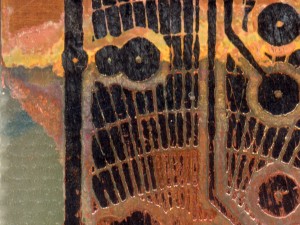Revolutionary!
PCB etched with plain salt! Electrochemical (anodic) etching.
First test setup:
– 5% Sodium Chloride NaCl (as table salt) solution
– Warm water ca. 60°C starting temperature
– Stirring (magnetic stir bar)
– 17V DC, 1 .. 5A
– Copper clad PCB as anode with Toner Pattern (HowTo)
– Copper clad PCB also as cathode.
– measured pH 6,8 about neutral.
Here it´s only done on a scrap sample, but hey – better than expected!
The reddish slur on the bottom of the jar seems to be Cu2O, maybe with CuOH and not metallic Cu (what I wrote first)..
No toxic blue waste water! (Blue is the colour of copper in solution.). We want the copper in the residue and not in solution.
.. I will find out it turns blueish after a while. Must be some interaction with the chloride ions. Must investigate further. But in the end, I dont care because all dissolved copper will end up on the cathode in the next electrolysis. Btw. the white fog is caused by the table salt, it contains a small amount of insoluble anticaking agents.











The insoluble stuff on the bottom is copper hydroxide. Only trace amounts of copper can go into solution, which is what’s causing the blue color.
Comment by Mike — 20 January 2012 @ 21:34
indeed very interesting!!!
looking forward to see me more fine docuementations on your electro-chemical tests.
Comment by 2 — 7 March 2012 @ 06:04